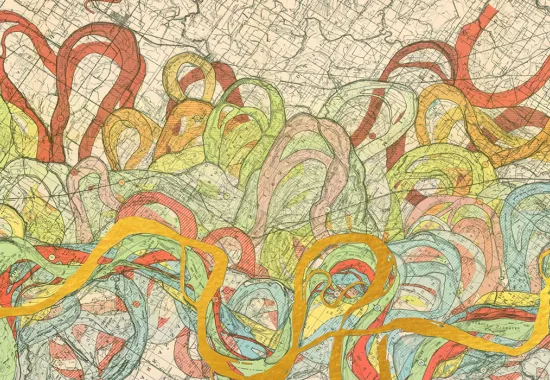“An Eros of Pitched Precision”: Heather Treseler’s Auguries & Divinations
Winner of the 2023 May Sarton New Hampshire Poetry Prize and a finalist for the New England Book Award for Poetry, Heather Treseler’s debut full-length collection Auguries & Divinations sings of ghosts and lovers, the patterns and migrations of birds, women who are not biological mothers but are mothers, nonetheless, and Massachusetts suburbs well-stocked with secrets. It’s a world made wondrous by a poet whose attention is honed by a keen and unassuming intelligence, an eye for all that is happening offstage and on, and an ear alert to the cadences of a formal tradition.
Auguries & Divinations opens with the speaker’s physical nostos, a homecoming in which she tracks the ghosts of her childhood. She is alert to the underside of her New England neighborhood with its veneer of propriety: “The first rule here is do not disturb the peace / or permit parking, the right to quiet enjoyment / of sprinklers and playsets, gas grills and badminton, / swinger clubs and pervy sex.” In this catalog, Treseler stashes the revelation of the neighborhood’s perversions at the end of her inventory of mundane, middle-class diversions, creating a jolt of surprise. But there is more at stake than neighborly gossip in this poem, as the reader discovers the neighborhood’s sickening impact on the speaker, in which its "surfaces enforce a silence as lethal / as measles—one that leaves no disfiguring mark / or pox but gums up the jaw, and kept me from / caring too much or saying exactly what I saw.” While there is humor in the speaker’s appraisal of her New England hometown of Newton, Massachusetts (a hometown she shares with literary godmother Anne Sexton), such silences can be coercive and potentially dangerous, particularly for a poet. Schooled in the codes of silence in Massachusetts’ upper-middle class suburbs, the child is an ambivalent witness to the elisions and omissions that a culture of secret-keeping enforces and camouflages through a front of respectability.
Heightened attention can be a counter-response to a cryptic adult world that breeds epistemological uncertainty and contradiction. As we progress through the collection, we learn that the speaker’s “wide-eyed” quality of attention may be borne out of the anxiety of living with an ill parent. The speaker’s mother suffers from a blood disorder that causes symptoms of purpura, blood vessels that leak blood under the skin. In Treseler’s hands, the mother’s condition becomes a conceit for “a strange beauty,” the body’s “artistic ambition” and sartorial regality (“an emperor’s robe purple”), and “some code or augury to read and remember.” With her dazzling metaphorical imagination, Treseler’s “Purpura” is a tour de force, made poignant by its aesthetic preoccupations and the speaker’s restrained panic (not unlike the “state of controlled panic” of the poet Elizabeth Bishop’s sandpiper):
"When the poet wrote I lost my mother’s watch,
we knew she meant more than a timepiece.
•••
When I lost my mother’s watch, I was thirteen.
The day, unaccountably bright. Fields of flora
bloomed under her skin as if she were a lavender
hat in Seurat’s famed painting."
Alluding to a line in Bishop’s poem “One Art” that gestures to the premature loss of her mother, Treseler’s poem astonishes in its precision of imagery, emotional restraint, and turns in meaning dramatized by brilliantly executed line breaks. A scholar of Bishop, Treseler shares several gifts with the famous poet: a style that is understated, yet keenly felt, a taste for irony as a defense against strong emotional content, and a wry attention to the eccentricities of the external world as if to encode deep emotion.
In tender tones, the lover’s body becomes a landscape that invites discovery and apperception, rather than possession.
The titular auguries and divinations of Treseler’s collection adumbrates a preoccupation with meaning-making. In “Egyptian Wing,” the child-speaker, spiritually and psychically “lost,” reflects that “mother / had a disorder of the blood and no one / would tell me anything I could/ believe of death.” Rejecting Christianity’s violent images of death, the speaker locates in the museum the Egyptian’s “creed / of birds” that appeals to her as a child hunting for signs that might be a bulwark against her mother’s mortality. The child considers, “Weren’t birds commuting / between a bitter earth and sky? Making / an eros of pitched precision? / Mothering a small body / toward its horizon.” Within the context of the collection, augury, the practice of reading and understanding omens through the observation of birds, also marks an investment in deciphering silence as a charged signifier, not an absence, which thrives in the knowing glances of adults who may try to shield their charge from reckoning with the precarity of her mother. Mothering, the speaker ultimately discovers in her adulthood, may also be conceived as a non-reproductive and reparative act. Augury also becomes a metaphor for a search for meaning in fraught times when patriarchy and misogynic violence conscript women into vulnerable positions or heteronormative roles, as one discovers in the “The Lucie Odes,” a long and moving poem about the speaker’s beloved who escapes a former life shaped by her ex-husband’s violence.
In the final poem “Aubade,” eros heralds the dispossession of self that the speaker seeks: “A lover’s sleeping body is a fallow field / leading to forest understory, saplings / and shrubberies too plentiful to count, / and to caves of salt, a mine that is yours /—that I should like to visit, dispossess.” In tender tones, the lover’s body becomes a landscape that invites discovery and apperception, rather than possession. In this poem, the slippage between body and land offers an opportunity for renewal, mutual discovery, and rest, while also calling for an attentive regard measured by respect towards the alterity of the other.
Auguries & Divinations tracks the making of a poetic consciousness that is engendered in crisis and that patiently observes and defamiliarizes our age’s toxic orthodoxies of gender and sexuality. It is also a collection that offers abundant rewards in repeated readings. Stitched together by tightly wound metaphorical and narrative threads, each section of the book affords provisions to any young poet seeking to learn how to weave autobiographical content and philosophical inquiry into a manuscript. Architectural in its scope, Auguries & Divinations showcases evolving metaphors that accrue meaning throughout the collection, deconstructing some of the problematic cliches about motherhood, while also introducing new idioms for thinking through the practice of mothering, and contrapuntal themes, such as fecundity and illness, violence and tenderness, friendship and eros.
Recommended
A Review of Dear Future by Jennifer Richter
A Review of Indian Winter by Kazim Ali
A Review of Glitter Road by January Gill O’Neil






